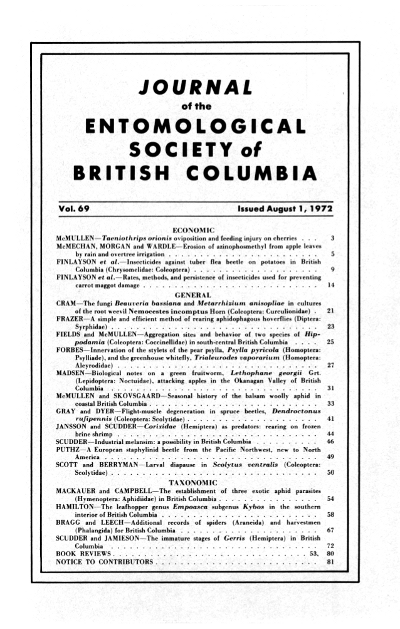Aggregation sites and behaviour of two wpecies of <i>Hippodamia</i> (Coleoptera: Coccinelidae) in south-central British Columbia
Keywords:
Coleoptera, Coccinelidae, i>Hippodamia</i>Abstract
<i>Hippodamia caseyi</i> Johnson and <i>H. oregonensis</i> Crotch overwinter in aggregation sites on mountain tops in south-central British Columbia. Each species selects distinctive overwintering sites. During the summer. <i>H. caseyi</i> is distributed mainly in the vallevs and lower mountain elevations, particularly in irrigated alfalfa fields. <i>H. oregonensis</i> is restricted to subalpine and alpine areas during the summer. Availability of suitable overwintering sites may be a limiting factor in the abundance of <i>H. caseyi</i>.References
Chapman, J.A. 1954. Studies on summit-frequenting insects in western Montana. Ecology 35:41-49.
Chapman, J.A., J.I. Romer and J. Stark. 1955. Ladybird beetles and army cutworm adults as food for grizzly bears in Montana. Ecology 36:156-158.
Edwards, J.G. 1957. Entomology above timberline: II. The attraction of ladybird beetles to mountain tops. Coleopterists' Bull. 11:41-46.
Downloads
Published
Issue
Section
License
Authors who publish with the Journal of the Entomological Society of British Columbia agree to the following terms:
-Authors retain copyright and grant the journal right of first publication with the work simultaneously licensed under a Creative Commons Attribution License that allows others to share the work with an acknowledgement of the work's authorship and initial publication in this journal.
-Authors are able to enter into separate, additional contractual arrangements for the non-exclusive distribution of the journal's published version of the work (e.g., post it to an institutional repository or publish it in a book), with an acknowledgement of its initial publication in this journal.
-Authors are permitted and encouraged to post their work online (e.g., in institutional repositories or on their website) prior to and during the submission process, as it can lead to productive exchanges, as well as earlier and greater citation of published work (See The Effect of Open Access).


